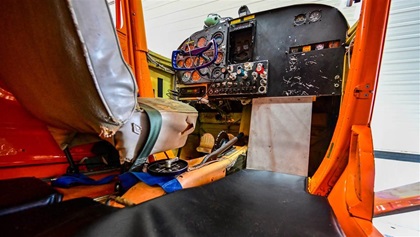Perfectly good airplane
Flying a modified Cessna 182
“Jumpers away!” is called on the CTAF, and that’s normally the cue for four skydivers to exit the right door, first balancing precariously on a small step attached to the right landing gear before freefalling from 10,500 feet above North Carolina’s Cape Fear Regional Jetport (SUT). An immediate hard left rudder input lowers the cabin door so it can be latched and secured.
 We’re on a training flight with Ed Scott, a parachutist and commercial pilot who founded Jumpers Away, a flight school created specifically to teach safe jump pilot techniques. Although there were no actual skydivers on this flight, he keeps it as real as possible. He instructs me to keep the speed up while quickly descending in a hard left spiral back down toward Howie Franklin Field.
We’re on a training flight with Ed Scott, a parachutist and commercial pilot who founded Jumpers Away, a flight school created specifically to teach safe jump pilot techniques. Although there were no actual skydivers on this flight, he keeps it as real as possible. He instructs me to keep the speed up while quickly descending in a hard left spiral back down toward Howie Franklin Field.
My head twists left to maintain sight of the imaginary jumpers’ canopies and we descend at speeds of 120 to 140 mph by reducing manifold pressure to 15 inches and propeller rpm to 2,200. Descent rates of 1,200 to 1,500 feet per minute allow us to get down quickly. We apply carburetor heat every so often while monitoring the Continental O-470’s CHT to avoid shock cooling.
“Well done, David—if this was a real jump,” Scott says.
Scott, who has logged more than 1,000 jumps, reminds me to aim for the jetty to line us up with the airport. Smith Island and the Cape Fear River are to the right. The smooth, coastal North Carolina air allowed an occasional foray into the yellow arc during the long spiral descent and a left downwind for Runway 5.
This modified version of the do-it-all family Skylane can carry five people—a jump pilot and four skydivers—to altitudes that are typically 12,000 feet above ground level. Additional modifications turn the carbureted, six-cylinder, single-engine airplane into a true workhorse.
The interior is spartan. All seats except one—the pilot’s seat—are removed (the co-pilot’s seat is re-installed for pilot training flights). They make way for a gymnastics-style cushioned mat spread across the floorboard. Seatbelt anchors are affixed to the floorboard to accommodate up to four adults sandwiched in close proximity. A 10-inch-wide plate affixed to the right landing gear covers the wheel and serves as a step for jumpers exiting the cabin.
Inside the cabin, the jump leader sits up front and faces rearward with his or her shoulders pinned to the lower right-hand instrument panel, and legs splayed out toward the other skydivers. Parachute packs, harnesses, helmets, goggles, and cameras are secured and double-checked prior to exiting the aircraft. All onboard—including the jump pilot—are vigilant to keep gear from snagging inside or on the way out. An errant parachute deployment can wrap around the rear empennage and lead to extreme control issues, or worse.
 From the pilot seat, the cockpit of N7247E—a brightly painted 1959 Cessna 182B model operated by Skydive Coastal Carolinas—appears almost normal. However, you’ll have to slide the seat a bit farther back than normal to accommodate the parachute that jump pilots must wear while flying skydivers to altitude. Early Cessna 182s, like this one, are significantly lighter on the elevator controls than their contemporary cousins. A jack screw raises or lowers the entire horizontal stabilizer allowing for a slightly different feel than managing an elevator trim tab.
From the pilot seat, the cockpit of N7247E—a brightly painted 1959 Cessna 182B model operated by Skydive Coastal Carolinas—appears almost normal. However, you’ll have to slide the seat a bit farther back than normal to accommodate the parachute that jump pilots must wear while flying skydivers to altitude. Early Cessna 182s, like this one, are significantly lighter on the elevator controls than their contemporary cousins. A jack screw raises or lowers the entire horizontal stabilizer allowing for a slightly different feel than managing an elevator trim tab.
The panel of this aircraft is strictly utilitarian. It has the usual six-pack of analog flight instruments, radio, transponder, and little else. It’s also slightly narrower than later models, earning the “narrow body” Skylane distinction. A sheet metal plate affixed to the lower instrument panel on the passenger side accommodates jump masters’ contortions while protecting the rudder pedals from errant stabs as they lean against the plate and survey the jumpers a final time before beginning their freefalls.
This airplane flew about 200 to 300 hours per year hauling 400 to 600 loads when it was strictly a jump airplane. At four jumpers per load, that equals between 1,600 to 2,400 jumpers per season, minimum. Now N7247E is most often used to train jump pilots.
“When the first 182 was rolled out in 1956, it was a godsend for skydiving,” Scott said. “With all but the pilot’s seat removed, it could hold four jumpers. It could fly with the right door removed, and the right gear and wing strut provided an excellent jump platform.”
Scott says that scores of 182s serve as jump airplanes around the country today.




